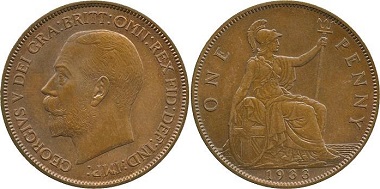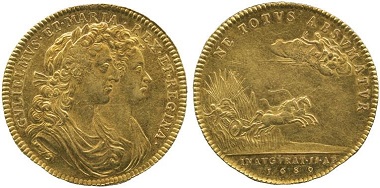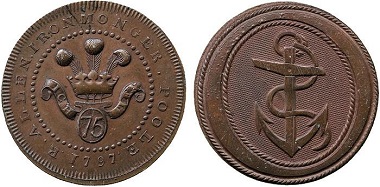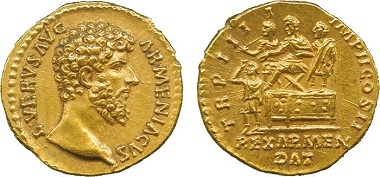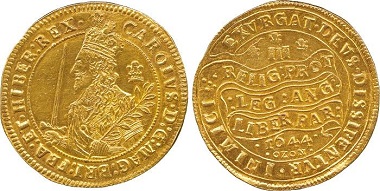02-05-2016 – 03-05-2016
Auctions 98 & 99
New world record for a copper penny at Baldwin’s
Baldwin’s Flagship London Auctions 98 & 99 took place on 3 and 4 May 2016 at their 399 Strand Saleroom. As ever, it was an important event, with over 2100 lots from many different areas of numismatics going under the hammer.
The auctions achieved in excess of an amazing £1.5 million, which exceeded all expectations. The auction room was full for all sessions, and the bidders in the room were joined by over 500 hopeful bidders online – a record number for a Baldwin’s auction. It was not to be the only record broken that day.
Lot 1070: 1933 George V Copper Pattern Penny. Sold: £72,000.
The highlight of the two-day sale came towards the end of the second afternoon, with the 1933 George V Copper Pattern Penny garnering bids from all over the world. After some intense bidding to start with, it was eventually wheedled down to just two telephone bidders, who went toe-to-toe for a good five minutes before the hammer finally came down on a price of £72,000.
The realised price was a New World Record for a Copper penny coin sold at auction, and was more than double the original estimate.
The history of the currency version of the 1933 Penny is well documented, but what is probably less known (especially outside of numismatic circles) is the rarity of the Pattern version. Whilst we know that seven currency versions of the penny exist, we also know that the Pattern version is even rarer – there are only four.
Of those four, one is in the Royal Mint Museum. The other 3 are in private hands, which makes this one of the rarest coins in British numismatics.
The coin was created by the moneyer Andre Lavrillier as a Pattern for the proposed 1933 Penny. It never happened, however, and the four examples that Lavrillier created were roundly dismissed by the Standing Committee on Coins Medals and Decorations in December 1932.
Coins of this stature are rarely offered at auction, and a World Record price realised is a gratifying moment for numismatists everywhere, proving that the market for the rarest of rare coins is still as strong as it ever was.
The auction kicked off with a wide and varied selection of Military Medals, expertly catalogued and valued by our new medals specialist Mark Smith.
Lot 2327: William & Mary (1688-1694), Coronation Gold Medal, 1689. Sold: £7,200.
Following the Military medals section was the Feldman Collection of British Coronation Medals. This meticulously-assembled collection was formed over many years by Dr Robert Feldman and his son, Joshua, who began after they stumbled upon a coronation medal of Edward VII at a coin show in California. Thirty years later, and the magnificent collection was offered to bidders at our saleroom.
It proved to be an extremely popular part of the auction, with almost every lot doubling its original estimate as multiple bidders, in the room and online, fought for the privilege of owning a piece of British history.
Lot 2628: Dorsetshire, Poole, Richard Allen. Copper Halfpenny, 1797 (one of only two known to exist). Sold: £4,080.
Next up was an extensive selection of British 18th Century Tokens – always an extremely popular section. During and after the British Industrial Revolution, there was a distinct shortage of small coinage, so many shopkeepers, traders and merchants began creating their own. The tokens proved so popular that they soon became used for marketing and political purposes. Their existence today highlights an intriguing time in British history, and their popularity at our auctions enhances the strong link between numismatics and history.
The two-day auction featured a number of fabulous collections, which were a huge honour for Baldwin’s to sell – especially as in many cases they were collections that we have helped to assemble over decades.
Lot 27: Roman, Lucius Verus (AD 161-169), Gold Aureus. Sold: £21,000.
One such collection was the Alfred Franklin collection of ancient coins, which set the standard for day two. A superb collection of Greek and Roman Ancient coins, put together carefully over many years with an unerring eye for quality and historical interest. The bidders agreed, and every single lot from the collection sold with the most frenetic bidding of the two days in the auction room and online.
The Ancient theme was continued with the next collection to come under the hammer – a fabulous and rare collection of Aksumite coins. The Kingdom of Aksumite was a huge civilisation on the Africa East Coast, with a number of significant achievements to their name: they were the second civilisation to adopt Christianity as their official faith; they were the first to feature crosses on their coins, and they even created their own alphabet (the Ge’ez alphabet). Despite this, very little is known of their Monarchs, and intriguingly we only know about many of their Kings because of the coins that still exist.
This fascinating history and the overall rarity of so many of these coins makes it a significant event when such an extensive collection comes up at auction. This was certainly the case on May 4.
Next was a selection of Ancient and British coins (we were in London, after all), and The Collection of a Classicist. This was a great opportunity for those in the room and watching online to acquire material that was fresh on the market after many years. What was seen as very much a ‘true numismatists’ collection was incredibly well-received by those searching for something perhaps a little rarer than is seen at most auctions around the world.
Lot 999: Charles I (1625-1649), Gold Triple Unite, 1644. Sold: £74,400.
And to round off the sale an equally strong section of British coins from a number of different eras. The undoubted highlight of this section was the World Record Price for the Lavrillier 1933 Pattern Penny – it was not however, the largest realisation on the day. That honour went to a rather charming Charles I triple Unite – one of the finest specimens we have seen – that sold for £74,400.
Overall, the auctions were one of the most successful in recent years, cementing Baldwin’s place as the premier numismatic auction house in the UK, and proving once again that the British numismatic market is as strong, if not stronger, than ever.
You can find the results list here.




